Certification of compostability
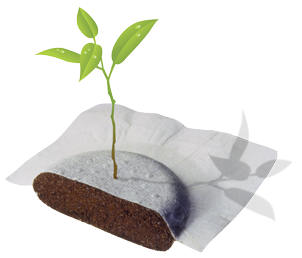 The process required to officially certify the compostability and biodegradability of E.S.E. (Easy Serving Espresso) standard paper pods started in autumn of 2010.
The process required to officially certify the compostability and biodegradability of E.S.E. (Easy Serving Espresso) standard paper pods started in autumn of 2010.
The positive results of the preliminary disintegration and biodegradability tests now allow the consortium to finally approach the true and proper certification of compostability.
The process should be completed in September 2012, with the confirmation that E.S.E. pods qualify to be discarded as compostable household waste.
The reference regulation would be the same applicable to the disposal of packaging: UNI EN 13432:2002.
Since UNI EN 13432:2002 does not cover “composite products” (definition applicable to the paper pod, the “content” of which is composed of 7 grams of ground coffee and two sheets of filter paper that securely enclose it) the Consortium E.S.E. requested and obtained approval to establish a “paper coffee pod product voluntary certification”.
The voluntary certification will initially be valid in Europe. The final objective however is global validity.
Each and every step in the compostability certification process was followed by:
SSCP (Italian Pulp and Paper Research Institute)
Biodegradability is intended as being: the determination of the percentage of mineralization and biodegradability of a product in mature compost.
In order for the biodegradability test to be successful, the product biodegradation process curve must reach the 90% range within 180 days maximum (two cycles of 90 days each).
Both biodegradability and disintegration tests are required to determine the actual compostability of a product.
In the initial phase of the test performance was good, as the E.S.E. paper pod biodegradation curve stayed within the average range.
On the 140th day of the test (90 + 50) the biodegradation curve had reached 87%, hence confirming the biodegradability of the E.S.E. paper pod.
Organic Waste System (OWS)
The positive results of the above mentioned preliminary tests failed to convince all coffee roasting member of the Consortium E.S.E., who undertook to further verify and cross validate them by means of a ring-test.
To cross-reference with absolute certainty the results of tests performed on E.S.E. paper coffee pods by the Consorzio Italiano Compostatori and those obtained by Organic Waste System (OWS) in Belgium, samples were swapped and tested again by both C.I.C. and OWS.
The samples successfully passed the ring tests conducted by both certification entities.
Certiquality
As stated in the foreword, there is only one reference regulation on the disposal of packaging: UNI EN 13432:2002.
Although the filter paper that wraps the ground coffee to form the E.S.E. pod could be considered “packaging” (polypropylene content above 25%), the current standard does not by definition cover any product/composite item or “stand alone unit” such as the E.S.E. paper coffee pod (composed of ground coffee and food grade filter paper that holds and wraps it). In regards to this last, 1% the maximum polypropylene content allowed by law.
Since UNI EN 13432:2002 does not cover “composite products” (see the “Foreword”), at the end of 2011 the Consortium E.S.E. officially asked C.I.C. and Certiquality to establish a “paper coffee pod product voluntary certification” that would not require changing any of the provisions set forth by the only reference regulation.
Between the beginning of January and April 2012, C.I.C. and Certiquality evaluated the E.S.E. “compostable product” requisites and drafted the related Technical Document (DT).
In April of 2012 the Consortium received the go-ahead from both certification entities, who confirmed the possibility of building a “pilot regulation” for the disposal of “compostable product” such as the E.S.E. paper coffee pod, with special emphasis on polyethylene content.
The E.S.E. standard paper pod forthcoming certification of compostability
Standard E.S.E. (Easy Serving Espresso) paper coffee pod: the first compostable food product
The E.S.E. Consortium has started the process required to obtain the certification of compostability and biodegradability.
E.S.E. pods will be discarded in the biodegradable waste bin.
Paris, 16 May 2012 – Milan 17 May 2012 – The Consortium E.S.E. announces the forthcoming certification of compostability for the E.S.E. paper pod, which would in fact make it the very first compostable food product in the mass retail market. It also recounts the steps that made it possible for E.S.E. paper coffee pods to become eligible for certification.
“It was not easy. Even though in the single-servings market it could seem rather ‘natural’ for paper pods to be compostable” – says Roberto Morelli, President of the Consortium E.S.E. and illycaffè Director of Global Marketing Projects – “it took almost three years of analysis and tests to prove the compostability and biodegradability of E.S.E. paper pod before we could stand here and announce the creation of a pilot regulation by which the compostability of coffee pods may be voluntarily certified throughout Europe.
Generally speaking, certifications of compostability are used for a limited range of products and “non-food” items like: toothbrushes, diapers, dishes and eating utensils, shopping bags, containers and naturally organic-based packaging material that are fully recyclable and renewable. Even if the word “compostable” is not yet commonly used by consumers, in some cases it has already been used to define products, processes or initiatives that have little or nothing to do with the true and proper certification.
The story the Consortium E.S.E. wishes to tell also includes the first encounter with the only reference regulation for waste disposal, UNI EN 13432:200, which only covers and regulates packaging. Since UNI EN 13432:2002 does not foresee “composite products” (definition applicable to the paper pod, the “content” of which is composed of 7 grams of ground coffee and two sheets of filter paper that securely enclose it) the Consortium E.S.E. requested and obtained approval to establish a “voluntary certification for the paper coffee pod product”.
“To foresee new applications for the regulation without altering its provisions can help anticipate the needs and demands of the market” – adds Luca Bardi, Certiquality Director of Inspections and Product Certification – “because surely the number of ‘compostable products’ to be disposed of similarly to paper pods is bound to increase”.
The Consortium E.S.E. is a precompetitive, international venue (that spans the entire world, from Europe to Japan and the Americas) where leading coffee roasters, coffee machine and pod production machinery manufacturers can meet and collaborate. Consortium member companies compete with each other and pursue their own missions, but share one common goal: that of continuing to develop a market that in the last few years, unlike any other in the food sector, has recorded double digits growth both in terms of servings and coffee maker sales.
“Today we can say that Standard E.S.E. single-serving coffee pods (or E.S.E. compatible versions) rank first in global distribution. Moreover, within the wide range of coffee preparation systems, it is the one most naturally suited to fulfil the emerging demand for eco-sustainability – concludes President Roberto Morelli – “it’s yet another value-adding feature we offer to consumers who have always been free to choose the option best suited to their taste and lifestyle, starting with a closed capsules-driven system or an E.S.E. paper pods open system”.
The Consortium for the Development and Protection of the Standard E.S.E. (Easy Serving Espresso) (*) is the only organization in the world to foresee the vertical integration of coffee roasters, espresso machine and pod production equipment manufacturers. Over the last few years E.S.E. has gained global fame as the “only open industrial standard” in the world, thanks to the technical characteristics that make each E.S.E. single-serving paper coffee pod compatible with all E.S.E. espresso machines. For several years coffee has been the only food market sector to record double digit growth in terms of product volume and invoiced sales attributable to coffee roasters and coffee machine manufacturers. The global appeal of the E.S.E. system and the Consortium was further proven by the recent enrolment of two industrial giants: Japanese coffee roaster Ueshima Coffee Company, and American coffee machines manufacturer KitchenAid. The E.S.E. system is represented within the Consortium, by the foremost coffee roasters and espresso machine manufacturers in the world. This group of strong companies compete against each other on the market and yet stand united in the firm belief that E.S.E. brand products truly complete the wide range of offerings in today’s single-serving coffee systems market.
For additional information:
Paola Redaelli – redaelli@eseconsortium.com / paola.redaelli@cohnwolfe.com
Tel. +39+2+20239.1 – +39+3497665892
E.S.E. Consortium c/o Cohn & Wolfe
Via Benedetto Marcello, 63 – 20124 Milano
(*) The Consortium promotes an espresso preparation system named E.S.E., which uses serving, meaning a single dose of coffee pressed between two layers of filter paper. The Consortium E.S.E. unites 13 of the leading companies in the espresso coffee market sector.
CAFES RICHARD (°) – DE LONGHI (+) – GROUPE SEB (+) – HANDPRESSO (+) – I.C.A.(•) ILLYCAFFE’ (°) – KITCHENAID (+) – KRAFT FOODS EUROPE (°) – LAVAZZA (°) – NESTLE’ HELLAS (°) – PHILIPS SAECO (+) – SARA LEE (°) – UESHIMA COFFEE CO. (°)
(+) espresso coffee machines manufacturer (°) coffee roaster (•) pod production machines manufacturer
Consumers and sustainability
The environment rises to #5 on the list of concerns
Ranking in second and third place are concerns that in certain ways derive from the first: political turmoil and unemployment; it is interesting to note that these issues claimed first place in Countries such as France, Germany, Brazil and Spain.
Environmental issues ranked fifth in this complex scenario, a significant rise compared to the survey conducted in 2008.
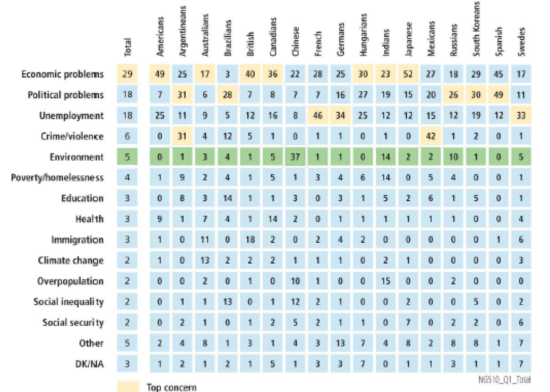
The table above nonetheless shows that consumers in industrialized Countries tend to be less concerned about global environmental issues than those in the so-called BRIC Countries, namely: Brazil, Russia, India and China.
Who is the environmentally sensitive consumer
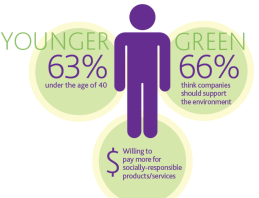 Two-thirds of consumers around the world, according to Nielsen(2), would rather buy products and services from companies that implement programs to support the environment.
Two-thirds of consumers around the world, according to Nielsen(2), would rather buy products and services from companies that implement programs to support the environment.
“Socially conscious consumers” tend to be younger (63% are under 40 years of age).
Almost half (46%) of them say they are willing to pay a little bit more for socially responsible products and services.
Euromonitor(3) recorded important regional differences in the social consciousness of consumers.
In North America and Europe consumers are seemingly less willing to pay a higher price than those in Latin America, the Middle-East/Africa and Asia-Pacific.
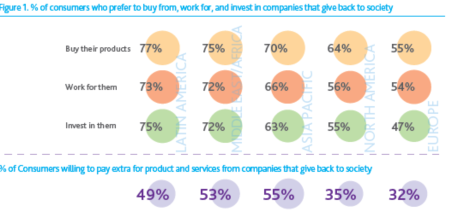
What consumers expect from companies
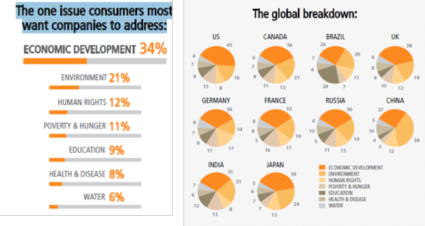
Consumers world-wide want to buy socially responsible products.
The vast majority (94%), given the chance, would rather buy a product tied to a “good cause”(4).
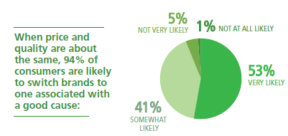
How to get consumers involved in 'greener' behaviour

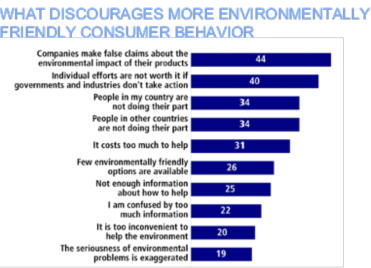
(1) Greendex 2010: Consumer Choice and the Environment – A Worldwide Tracking Survey is a comprehensive measure of consumer behaviour in 65 areas relating to housing, transportation, food and consumer goods. Greendex 2010 ranks average consumers in 17 countries. (2) Source Nielsen survey of more than 28,000 online respondents from 56 countries around the world 2011. (3) Source Euromonitor. Green Influencer 2011. (4) 2011 Cone/Echo Global CR Opportunity Study (5) Source National Geographic Green Index 2010.
Scenarios
One of the most promising markets, with growth rates among the highest in the global consumer market and a very wide-range of product offerings. An incredible evolution, that of the portioned coffee market, one that started in 2002/2003 and continues to undergo effervescent growth and transformation: the traditional offer of a “simple” raw material/commodity (whole or ground beans) became a consumer product/service (coffee ready to serve in the cup). A transformation validated by the latest consumer trends and the explosive dynamics of a wide variety of open – semi-open – closed and multi-beverage system offerings. Plastic and aluminium characterize the so-called closed systems, while paper is predominant in open systems, which give consumers true freedom of choice. All of these systems still hold immense potential for growth. The solutions launched on the portioned coffee market, supported by suitable distribution and information, scored premium prices and the immediate approval of consumers, whose loyalty could be ensured through long term subscriptions and accessories.
We are witnessing a phenomenon that is not an evolution, it is a revolution that responds to the needs of the consumer. The key lies in giving anyone (expert or not) the opportunity to make themselves a good cup of coffee in a way that is simple, clean, efficient and in the case of paper pods, also eco-friendly.
Gone are the days when only a few, elite connoisseurs could make good coffee at home (with coffee grinder, machine and accessories taking up a lot of kitchen space); today espresso (and other things) can be made easily and cleanly (since it is pre-measured and packed) in a minimal amount of space and readily enjoyed at home, at the office, at restaurants, on airplanes and so on. This also includes all places where the amount of coffee to be made could not possibly justify (or allow) using “professional” equipment.
A little more than ten years ago this was made possible by a “system” (machine+coffee serving) that delivers excellent coffee right into the cup of the consumer time after time, regardless of daily consumption habits or … expertise.
In full respect of the best coffee preparation traditions (most clearly demonstrated by the paper pod), certain variables that are important to yield a beverage of good quality (grind size; tamping pressure; water temperature; flow speed etc.) have been resolved uphill, to replicate the “touch” of a professional barista out of a true and proper coffee bar.
Until five years ago, a few operators who only offered “closed systems: dominated this market: the same company sold coffee and machines, which worked exclusively with each other. This effectively obligated the customer to use products made by that company. Today the situation is vastly different also because these options are now flanked by “semi-open” and completely open systems (like machines and pods that bear the E.S.E. mark). This means that today the consumer can freely choose and use different combinations of brand name coffee and machines.
The Consortium E.S.E. felt it was important to provide the single-servings coffee market with guidelines by which to start defining its basis and systems.
What the market offers
What is a system?
How are systems classified?
Open System. Allows different brands of coffee and machines to be used interchangeably, thanks to a predefined standard. The consumer may choose whichever machine and coffee combination he prefers, since manufacturers abide by a standard that allows the industry to create, plan and operate more interactively with the market. The only open system currently on the market is in fact the standard E.S.E.
Semi-open system. Small associations with few member companies; technically it is an open system, but not registered as such.
Closed system. Also defined as being a proprietary system. It is a system protected by patents both on the machine and the pod. The consumer who chooses it can only use it by purchasing that specific brand and type of coffee. There are numerous examples of companies that launched proprietary systems of their own and control them directly, although their approach to the market may differ.
Product types
Channels
Preparation
New proposals
Systems that offer greater versatility in terms of making espresso and long coffee. These systems allow consumers to make both versions with the same machine. These markets require large investments, and new products are being launched at an extremely rapid pace.
Numerous new players are trying to gain market shares from different starting positions. A critical factor for everyone’s success lies in offering consumers an integrated system.
The new competitive challenge
“Coevoluzione: la nuova sfida competitiva”
Gli operatori si stanno facendo carico di tutta la chiarezza necessaria come categoria, come sistema, come industria perché il consumatore possa apprezzare tutto quanto stanno facendo all’interno di questo mercato?
Si può partire da due presupposti: in sistemi complessi, i comportamenti cooperativi pagano di più dei comportamenti competitivi; questo non significa negare i comportamenti competitivi, ma piuttosto che nei sistemi complessi è bene che si metta insieme un po’ di cooperazione con tanta competitività per ottenere buoni risultati.
In questo tipo di mercato, ci sono delle dinamiche precompetitive che possono indirizzare il consumatore meglio che in una situazione totalmente competitiva e si può concorrere nel trovare un linguaggio comune che il consumatore possa capire e valorizzare.
Questo ovvierebbe al rischio che i consumatori rinviino le decisioni di acquisto data l’eccessiva confusione dell’offerta.
La cooperazione implica una grande attenzione nei confronti del consumatore, che è attualmente un butterfly consumer. Nel caso in cui non si riesca a fare chiarezza nel settore, il rischio maggiore è quello che i consumatori tendano a favorire sempre e comunque i new comers, a causa della scarsa chiarezza informativa.
Nel nuovo scenario di iper-competitività dei mercati, il meccanismo di guida maggiormente riconosciuto è il processo di convergenza che dirige la traiettoria evolutiva di molte realtà industriali.
Molte società, per essere all’altezza del mercato e della complessa gamma di esigenze, dovrebbero integrare capacità asimmetriche di altre società, o di altri concorrenti.
La sfida delle coevoluzione non è solo una nuova terminologia, ma una nuova modalità concorrenziale.



